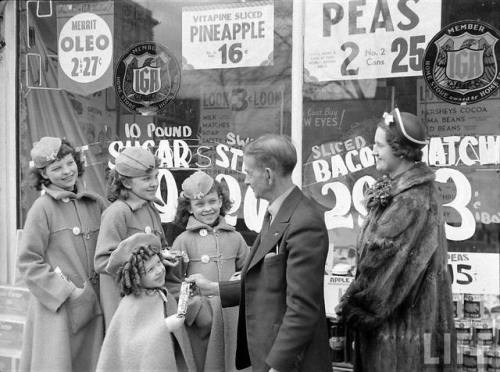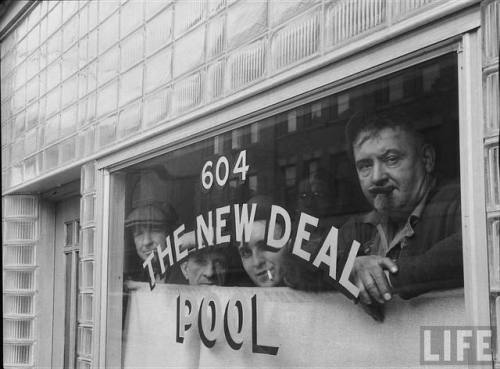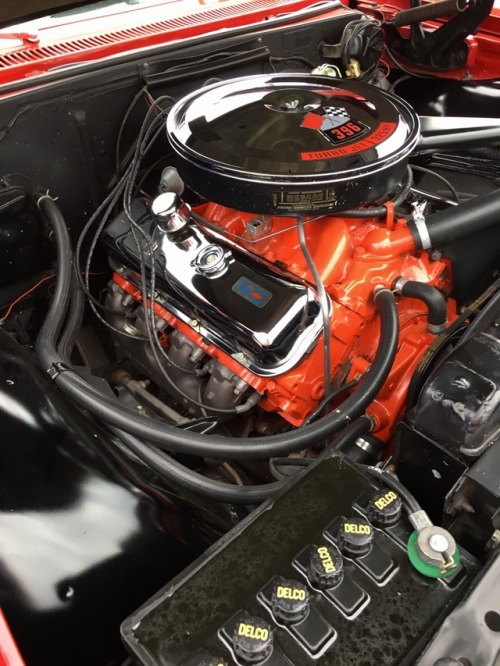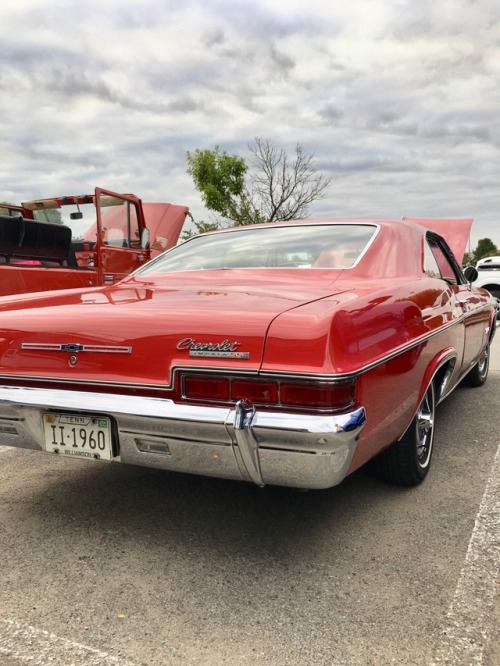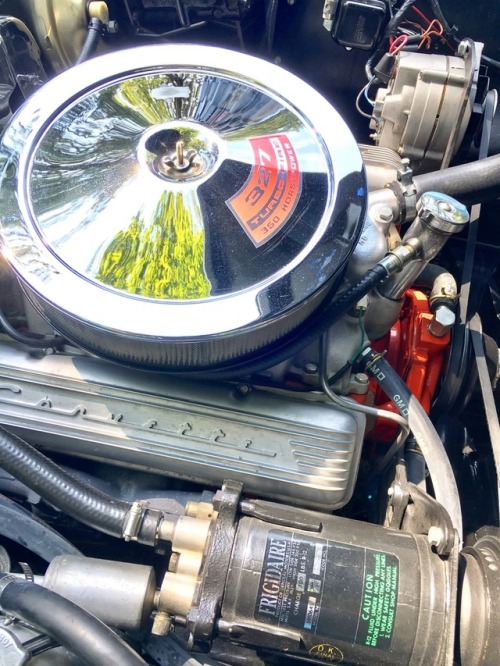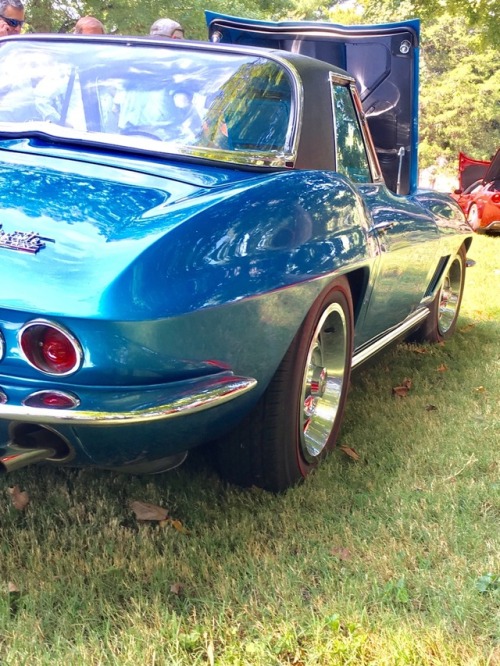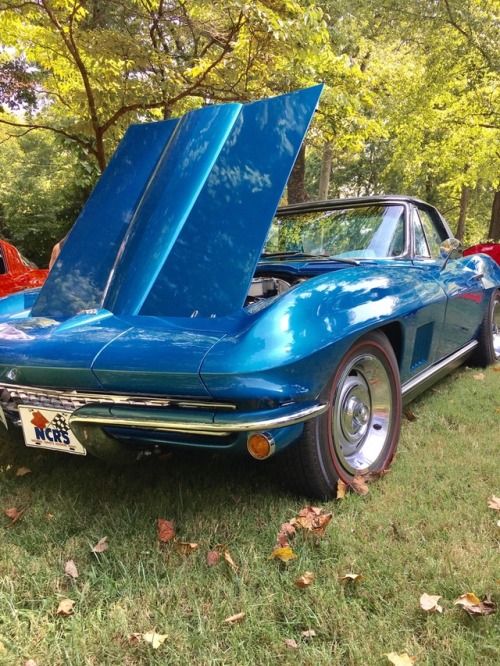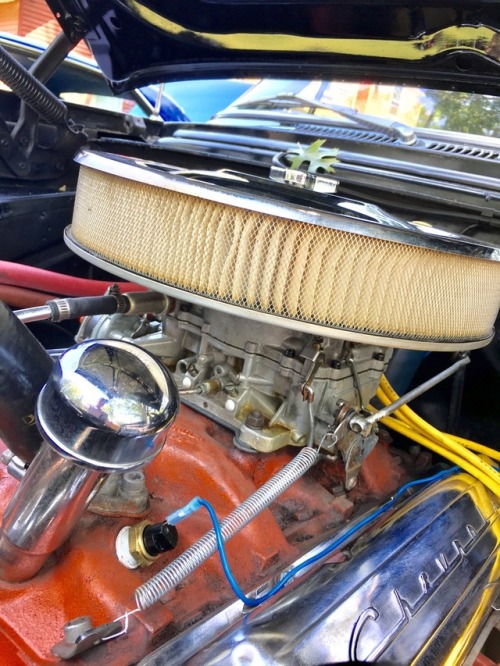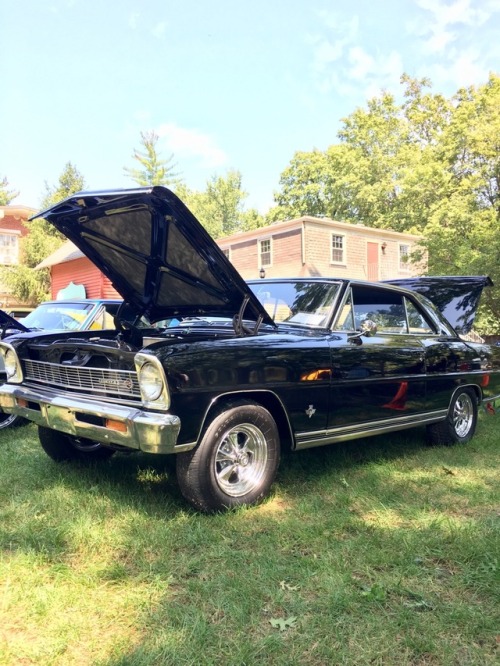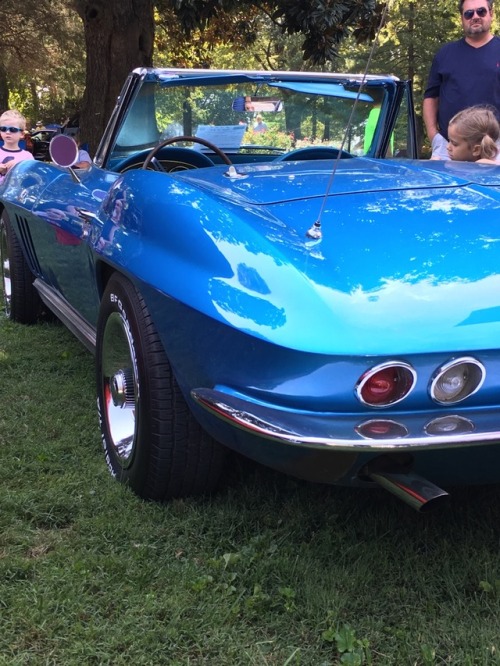#muncie
Okay, not a typical definition of a muscle car, but I love this 1966 Chevrolet Impala Super Sport! Loooong, boat-like body and hubcaps, but look at that 396 / 325 horsepower rat big block seething under the hood! And a 4speed to boot! (Muncie? Probably.) And bucket seats. And check out the gauge cluster on the console. I’d love to know if it’s a Muncie close ratio or wide ratio as well as the rearend differential. This car looks like your grandmother’s grocery-getter. But from redlight to redlight, it’ll surprise that other person beside you!
Post link
I try to take deep breaths when I run across original 1969 Z/28s. (Deep breath). Protect-o-plate looked correct. “DZ” stamped on engine block pad under the alternator. Owner wasn’t around and it was a public car show, so I couldn’t get too much more nosey. Anyway, gauge cluster on the console, 4speed, vinyl roof, small block, Endura bumper. Sigh, ‘69 Z/28….
Post link
1967 Corvette with a 327 / 350 horsepower smallblock and a Muncie 4-speed. This was at a local car show a few weeks ago. The owner said the vinyl roof was factory.
Post link
Spotless 1966 Chevelle Super Sport with a 396 / 360 horsepower factory rat motor connected to a Muncie with a Hurst shifter. Not sure of the rearend gearing or the Muncie type. But this car is absolutely breathtaking!
Post link
1966 Chevy II Super Sport. This girl, dressed in “Tuxedo Black”, has a 327 four barrel (Rochester or Carter?) and I’m not sure if it’s the 275 or the 350 horsepower version. Also don’t know if that’s a Muncie or a Saginaw (probably Saginaw since it’s a small block) four speed under her but she’s got a Hurst linkage. There’s a stiff positraction rearend and an AM radio; so basic but the cool-factor is way up there! If you’ve been following me (like 13,000+ have in less than 176 days since I started this Tumblr) for any time, you know that Craiger S/S rims are the only aftermarket rims I can tolerate. :-). I like my classic cars factory and this girl is a perfect 60’s specimen!
Post link
1966 427 4-speed Corvette. This is a dream car for me! Not sure if this is the 425 or the 390 horsepower version. Absolutely gorgeous, immaculate car at a local car show today!
Post link

This post, including the image above, comes from Karmen Beecroft, Digital Projects Librarian for Digital Initiatives at Ohio University. I’ve put in a cut, so make sure you click through to read the entire post!
The eleventh of twelve children and the youngest daughter, Anne Claire Keating was born to Irish immigrant parents on February 25th, 1879 in Terre Haute, Indiana. Her father Edward, a stone mason—and “artist in marble” according to one newspaper– had arrived on American shores some eighteen years previously, at the beginning of the Civil War.(1) In Missouri, he met and soon married Ellen Cadden, herself a childhood transplant from the Emerald Isle. Half of Ellen’s children would die in the coming decades, but stalwart Anne seldom left her mother’s side.
Then known as Anna, Keating graduated Terre Haute High School in 1897 and immediately enrolled in the nearby Indiana State Normal School, which she attended until 1899. At the turn of the century, she dropped out to become Second Assistant Librarian under the direction of Arthur Cunningham, founder of the Normal School library. In 1901, Keating received a promotion to first assistant librarian, a position she would continue to hold for another two decades—minus a leave of absence from September 1907 to June 1908 to complete her library science degree at the Pratt Institute in New York. During that period, she lived in a Brooklyn boardinghouse while also attending the Brooklyn Institute as a “special student.” Her married sister Margaret lived nearby, helping her settle in and attending her when a sudden “nervous affection” which “made it painful for her even to dress her hair” kept her out of school for two days.(2) In the coming years, the two would several times vacation together on the coast for extended periods in service to Keating’s health.
Upon completing her degree, Keating returned to her parents’ home in Terre Haute, which she also shared with her widowed sister Mary. Her father and eldest brother both died in 1913; the three women moved out of the family home soon after. As president of the Terre Haute Women’s Club and patroness of the Alpha Section of the Normal School Women’s League, Keating frequently made the local papers while promoting educational lectures and mentoring her younger sorority sisters. At the library, she assumed the duties of cataloger during a period of great expansion while somehow also finding time to pursue graduate coursework at the University of Wisconsin. A satirical student publication issued around this time sketches the scene at the Normal School library in a few lines:
Misses Marshall, Keating, Darrow and Brown,
Cunningham’s satellites, and ne’er do they frown;
Four good varieties, thick, fat, and thin;
At five o’clock, mornings, their work it begins.(3)
At the age of 42, it seemed as though Keating had finally gotten her big break when a position opened up as head of the Muncie branch of the Normal School library. “I anticipate a very pleasant time at Muncie,” she told the Terre Haute Saturday Spectator. However, Keating’s mother died while preparing to make the move, derailing her ambitions; Keating remained in Terre Haute. Four years later, another opportunity for advancement arrived hand-in-hand with personal tragedy. In January 1925, her six-year-old niece Frances, of whom she had partial custody, developed acute laryngitis while in her aunts’ care and died suddenly. Several months later, Keating, then 46, left her family and hometown to assume the position of Ohio University Librarian in the small Appalachian town of Athens, some 350 miles east of Terre Haute.
Keating, the university’s third Librarian and the first woman to fill that role, arrived at Athens with an agenda. The Green and White, Ohio University’s student newspaper, reported that
the very smell of the paint and varnish used in the library redecoration attests to the initiative and leadership of the new librarian. Several changes in location and library procedure have already been announced, and are now being planned and executed. Stacks privilege[s] to be granted to students soon[; this] comes from Miss Keating’s effort to make the library more useful and attractive.(4)
Keating immediately embarked upon an ambitious remodeling plan for the crowded Carnegie Library, including “a new reference room and more commodious reading room,” as well as “a better and more complete children’s room.” In 1925, Keating’s charges numbered just 50,000 books and four assistants.
Echoing her Terre Haute occupations, Keating swiftly moved to embed herself in the Athens university culture, becoming first secretary and later president of the OU chapter of the American Association of University Women. A dedicated patroness of the Theta Phi Alpha sorority, she often collaborated with popular Dean of Women Irma Voigt to facilitate student programming and provide mentorship. An enduring autodidacticism led Keating to pursue a fifth course of study at George Washington University and by 1931 she had added a Bachelor of Arts degree to her ever-growing portfolio.
1931 also saw the completion of the Edwin Watts Chubb Library and the transfer of the Carnegie stacks—now housing 70,000 volumes—to the new building. Chubb Library provided space for some 240,000 books and 600 simultaneous readers, a threefold increase over the study space available at Carnegie. Head counts conducted by Keating’s staff revealed that the new library received 20,000 visits a month during the opening years of the Great Depression, a great increase over usage patterns observed in the 1920s. The incoming university president Herman James dealt the Library’s newfound popularity a blow, however, when he directed that Keating’s decade-long open stacks policy be discontinued. “It is felt that lower classmen are not ready for undirected browsing among so many volumes,” Keating reservedly reported to The Green and White. “They must first be educated for this responsibility.” (5) The closed stacks mandate proved extremely unpopular in subsequent years, though Keating noted in exasperation that only half the senior class ever reported to receive their passes. Nevertheless, she continued to remove barriers when able, adding a fiction-heavy open shelf collection just a semester after James’ announcement.
In 1937, Keating returned to her Normal School roots with the development of a 3-credit course for prospective educator-librarians. Keating tartly noted that her class—the first in school library administration offered by a state university in Ohio– “in no sense prepares the student for full time librarianship.”(6) Though enrollment varied, Keating continued to offer the course for twelve years until her retirement in 1949 at the age of 70.
Over the 24 years of her tenure at OU the student body as a whole grew 400%. Keating reacted by growing the collections to 180,000 volumes and increasing her staff to 12 assistant librarians and three clerical assistants. An army of fifty student workers sprang up to deal with the closed stacks system and increased circulation. Keating’s retirement coincided with that of Dean Voigt, her longtime collaborator. The Ohio Alumnus hinted at intriguingly unspoken controversies during their long careers: “both women were in positions in which it was impossible to please all person having dealings with them. There are doubtless those who do not agree with some of their actions and decisions. But, many fewer, we’ll warrant, is the number who do not credit them with an earnest desire to deal fairly in the matters within their wide jurisdictions.”(7)
Upon quitting Athens, Keating joined her sister Margaret in Croton-on-Hudson, New York, until Margaret’s death in 1952. At the age of 73, Keating returned for a last time to Terre Haute to live with her widowed sister-in-law Clara. A few months later, Keating herself died of heart disease. From “Cunningham’s satellite” to university administrator, Anne Keating’s life is one of conflicting drives and stymied ambitions finally realized. As an unmarried daughter, her responsibilities were culturally prescribed by the needs of the family, even as her remaining family members assumed responsibility for her welfare later in life. She never let these pressures constrain her mind, however—during the 26 years she served at the Normal School library, she pursued coursework through three different universities and sought continually to further her education through reading and lectures. At Ohio University, her evenhanded management saw her library safely through the Great Depression and World War II. Though she personally disliked publicity, “Miss Keating’s” legacy is indeed a very public one—the modern library system she founded, with its emphasis on pedagogy and usability, forms the basis of our institution today.
Notes
1 Terre Haute Saturday Evening Ledger [Terre Haute, IN] 2 April 1881: 8.
2 Terre Haute Sunday Spectator [Terre Haute, IN] 16 November 1907
3 Denehie, Elizabeth. “A Eulogy on our Faculty.” Normal Advance [Terre Haute, IN] June 1915: 309.
4 “Introducing Miss Keating.” The Green and White [Athens, OH] 9 February 1926: 1.
5 “New Library Rules Issued.” The Green and White [Athens, OH] 27 September 1935: 1.
6 The Green and White [Athens, OH] 26 February 1937: 4.
7 Williams, Clark E. “From the Editor’s Desk” The Ohio Alumnus [Athens, OH] May 1949: 2.

